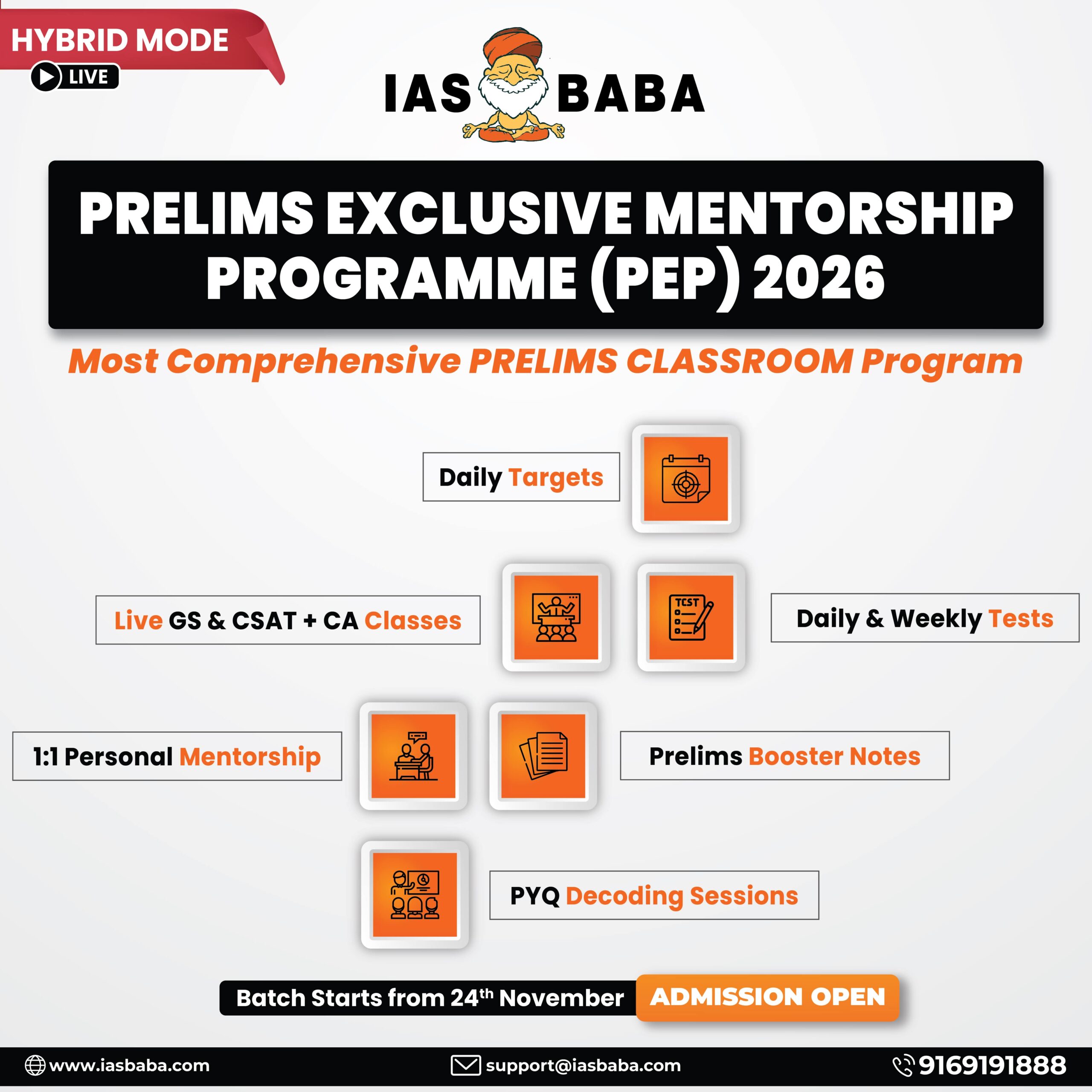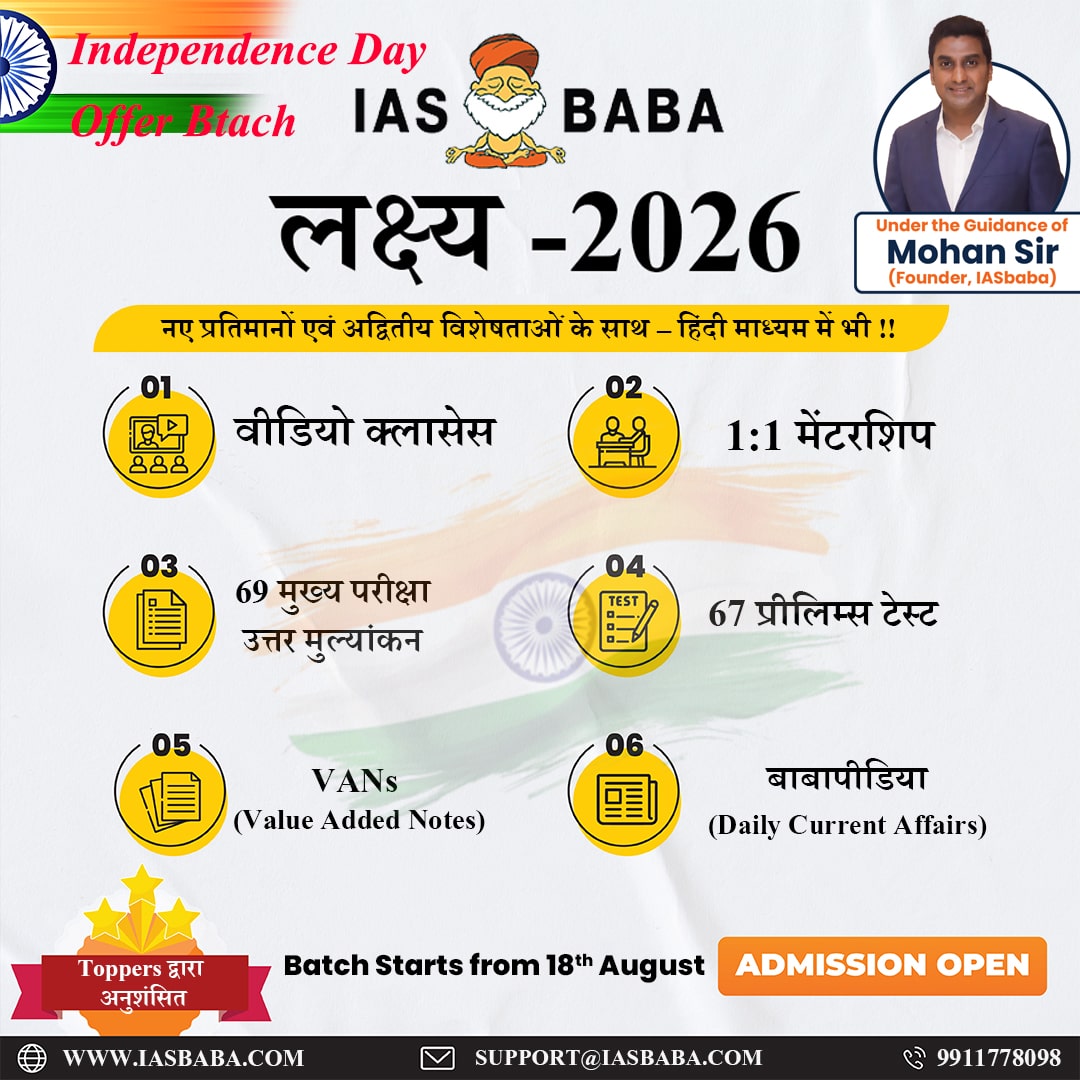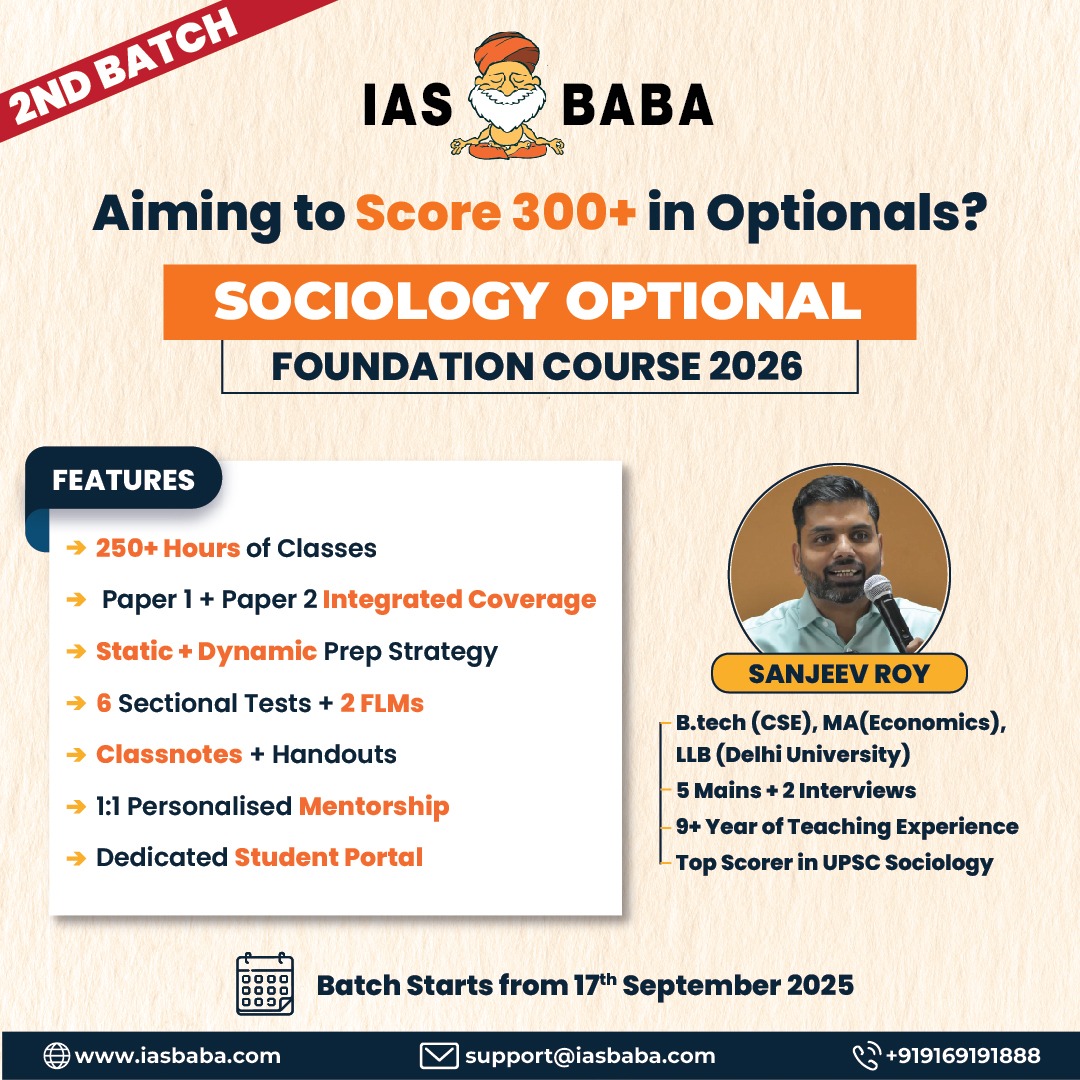IASbaba Prelims 60 Days Plan, Rapid Revision Series (RaRe)
Archives
Hello Friends
The 60 Days Rapid Revision (RaRe) Series is IASbaba’s Flagship Initiative recommended by Toppers and loved by the aspirants’ community every year.
It is the most comprehensive program which will help you complete the syllabus, revise and practice tests on a daily basis. The Programme on a daily basis includes
Daily Prelims MCQs from Static (Monday – Saturday)
- Daily Static Quiz will cover all the topics of static subjects – Polity, History, Geography, Economics, Environment and Science and technology.
- 20 questions will be posted daily and these questions are framed from the topics mentioned in the schedule.
- It will ensure timely and streamlined revision of your static subjects.
Daily Current Affairs MCQs (Monday – Saturday)
- Daily 5 Current Affairs questions, based on sources like ‘The Hindu’, ‘Indian Express’ and ‘PIB’, would be published from Monday to Saturday according to the schedule.
Daily CSAT Quiz (Monday – Friday)
- CSAT has been an Achilles heel for many aspirants.
- Daily 5 CSAT Questions will be published.
Note – Daily Test of 20 static questions, 10 current affairs, and 5 CSAT questions. (35 Prelims Questions) in QUIZ FORMAT will be updated on a daily basis.
To Know More about 60 Days Rapid Revision (RaRe) Series – CLICK HERE
60 Day Rapid Revision (RaRe) Series Schedule – CLICK HERE
Important Note
- Comment your Scores in the Comment Section. This will keep you accountable, responsible and sincere in days to come.
- It will help us come out with the Cut-Off on a Daily Basis.
- Let us know if you enjoyed today’s test 🙂
- You can post your comments in the given format
- (1) Your Score
- (2) Matrix Meter
- (3) New Learning from the Test
Test-summary
0 of 35 questions completed
Questions:
- 1
- 2
- 3
- 4
- 5
- 6
- 7
- 8
- 9
- 10
- 11
- 12
- 13
- 14
- 15
- 16
- 17
- 18
- 19
- 20
- 21
- 22
- 23
- 24
- 25
- 26
- 27
- 28
- 29
- 30
- 31
- 32
- 33
- 34
- 35
Information
The following Test is based on the syllabus of 60 Days Plan-2025 for UPSC IAS Prelims 2025.
To view Solutions, follow these instructions:
- Click on – ‘Start Test’ button
- Solve Questions
- Click on ‘Test Summary’ button
- Click on ‘Finish Test’ button
- Now click on ‘View Questions’ button – here you will see solutions and links.
You have already completed the test before. Hence you can not start it again.
Test is loading...
You must sign in or sign up to start the test.
You have to finish following test, to start this test:
Results
0 of 35 questions answered correctly
Your time:
Time has elapsed
You have scored 0 points out of 0 points, (0)
| Average score |
|
| Your score |
|
Categories
- Not categorized 0%
| Pos. | Name | Entered on | Points | Result |
|---|---|---|---|---|
| Table is loading | ||||
| No data available | ||||
- 1
- 2
- 3
- 4
- 5
- 6
- 7
- 8
- 9
- 10
- 11
- 12
- 13
- 14
- 15
- 16
- 17
- 18
- 19
- 20
- 21
- 22
- 23
- 24
- 25
- 26
- 27
- 28
- 29
- 30
- 31
- 32
- 33
- 34
- 35
- Answered
- Review
-
Question 1 of 35
1. Question
With reference to the architecture of Harappa civilisation, consider the following statements:
- Indus Valley Civilisation sites do not have large monumental structures.
- The Harappan towns were laid out in a rectangular grid pattern.
- The Harappans used burnt mud bricks joined together using gypsum mortar.
How many of the above statements are correct?
Correct
Solution (c)
Explanation:
- The city was divided into two parts–an upraised citadel and the lower-part of the city. However, Indus Valley Civilisation sites do not have large monumental structures such as temples or palaces for rulers unlike Egyptian and Mesopotamian Civilisation. (Hence option 1 is correct)
- The remains of Harappa and Mohenjo-daro reveal a remarkable sense of town planning. The towns were laid out in a rectangular grid pattern. The roads ran in north-south and east-west direction and cut each other at right angles. (Hence option 2 is correct)
Mainly three types of buildings have been found in the excavation sites – dwelling houses, public buildings and public baths. The Harappans used burnt mud bricks of standardised dimensions for the purpose of construction. Many layers of well-baked brick were laid out and then joined together using gypsum mortar. (Hence option 3 is correct)
Incorrect
Solution (c)
Explanation:
- The city was divided into two parts–an upraised citadel and the lower-part of the city. However, Indus Valley Civilisation sites do not have large monumental structures such as temples or palaces for rulers unlike Egyptian and Mesopotamian Civilisation. (Hence option 1 is correct)
- The remains of Harappa and Mohenjo-daro reveal a remarkable sense of town planning. The towns were laid out in a rectangular grid pattern. The roads ran in north-south and east-west direction and cut each other at right angles. (Hence option 2 is correct)
Mainly three types of buildings have been found in the excavation sites – dwelling houses, public buildings and public baths. The Harappans used burnt mud bricks of standardised dimensions for the purpose of construction. Many layers of well-baked brick were laid out and then joined together using gypsum mortar. (Hence option 3 is correct)
-
Question 2 of 35
2. Question
With reference to Harappan seals, consider the following statements:
- Harappan seals are only found in square shape.
- The script was written from right to left on one line and left to right on another line.
- The common animal motifs found on seals are humped bull, rhinoceros and cow.
- Pashupati Seal was discovered at Harappa and depicts a deity sitting cross-legged.
How many of the above statements are correct?
Correct
Solution (a)
Explanation:
- Archaeologists have found numerous seals of different shapes and sizes all across the excavation sites. While most of the seals are square, it was found that triangular, rectangular and circular seals were also being used. (Hence option 1 is incorrect)
- Most of the seals have inscriptions in a pictographic script which is yet to be deciphered. The script was written mostly from right to left, but, bidirectional writing style i.e. right to left on one line and left to right on another line has also been found. (Hence option 2 is correct)
- Animal impressions were also there (generally five) which were carved intaglio on the surfaces. The common animal motifs were unicorn, humped bull, rhinoceros, tiger, elephant, buffalo, bison, goat, markour, ibex, crocodile, etc. However, no evidence of cow has been found on any seal. (Hence option 3 is incorrect)
Pashupati Seal was made up of steatite seal discovered at Mohenjo-daro. The seal depicts a human figure or a deity seating cross-legged. The figure, referred to as Pashupati wears a three-horned headgear and is surrounded by animals. An elephant and a tiger are there on the left side of the figure while a rhinoceros and a buffalo are seen on the right side. Two antelopes are shown below the seat of the figure. (Hence option 4 is incorrect)
Incorrect
Solution (a)
Explanation:
- Archaeologists have found numerous seals of different shapes and sizes all across the excavation sites. While most of the seals are square, it was found that triangular, rectangular and circular seals were also being used. (Hence option 1 is incorrect)
- Most of the seals have inscriptions in a pictographic script which is yet to be deciphered. The script was written mostly from right to left, but, bidirectional writing style i.e. right to left on one line and left to right on another line has also been found. (Hence option 2 is correct)
- Animal impressions were also there (generally five) which were carved intaglio on the surfaces. The common animal motifs were unicorn, humped bull, rhinoceros, tiger, elephant, buffalo, bison, goat, markour, ibex, crocodile, etc. However, no evidence of cow has been found on any seal. (Hence option 3 is incorrect)
Pashupati Seal was made up of steatite seal discovered at Mohenjo-daro. The seal depicts a human figure or a deity seating cross-legged. The figure, referred to as Pashupati wears a three-horned headgear and is surrounded by animals. An elephant and a tiger are there on the left side of the figure while a rhinoceros and a buffalo are seen on the right side. Two antelopes are shown below the seat of the figure. (Hence option 4 is incorrect)
-
Question 3 of 35
3. Question
With reference to the sculptures of the Harappa civilisation, consider the following statements:
- The Harappa bronze statues were made by Cire Perdue technique.
- The Dancing Girl is the world’s oldest bronze sculpture.
- Terracotta sculptures were made using pinching method.
How many of the above statements are correct?
Correct
Solution (c)
Explanation:
- The Harappan Civilisation saw a wide scale practise of bronze casting. The bronze statues were made using “lost wax technique” or “Cire Perdue”. In this technique, wax figures are first coated with wet clay and allowed to dry. The clay coated figures are then heated, allowing the wax inside to melt. The wax is then poured out through a tiny hole and liquid metal is poured inside the hollow mould. After the metal has cooled down and solidified, the clay coat is removed and a metal figure of the same shape as the wax figure is obtained. (Hence option 1 is correct)
- The Dancing Girl is the world’s oldest bronze sculpture. Found in Mohenjo-daro, this four inch figure depicts a naked girl wearing only ornaments. She stands in a ‘tribhanga’ dancing posture with the right hand on her hip. (Hence option 2 is correct)
Terracotta refers to the use of fire baked clay for making sculptures. Compared to the bronze figures, the terracotta sculptures found are less in number and crude in shape and form. They were made using pinching method and have been found mostly in the sites of Gujarat and Kalibangan. (Hence option 3 is correct)
Incorrect
Solution (c)
Explanation:
- The Harappan Civilisation saw a wide scale practise of bronze casting. The bronze statues were made using “lost wax technique” or “Cire Perdue”. In this technique, wax figures are first coated with wet clay and allowed to dry. The clay coated figures are then heated, allowing the wax inside to melt. The wax is then poured out through a tiny hole and liquid metal is poured inside the hollow mould. After the metal has cooled down and solidified, the clay coat is removed and a metal figure of the same shape as the wax figure is obtained. (Hence option 1 is correct)
- The Dancing Girl is the world’s oldest bronze sculpture. Found in Mohenjo-daro, this four inch figure depicts a naked girl wearing only ornaments. She stands in a ‘tribhanga’ dancing posture with the right hand on her hip. (Hence option 2 is correct)
Terracotta refers to the use of fire baked clay for making sculptures. Compared to the bronze figures, the terracotta sculptures found are less in number and crude in shape and form. They were made using pinching method and have been found mostly in the sites of Gujarat and Kalibangan. (Hence option 3 is correct)
-
Question 4 of 35
4. Question
With reference to the pottery of Harappan civilisation, consider the following statements:
- Polychrome pottery is characterised by geometric patterns in red and black colours.
- Plain pottery is of red clay with a grey slip only.
- Miniature vessels were also prevalent during the Harappan civilisation.
How many of the above statements are correct?
Correct
Solution (b)
Explanation:
-
- Polychrome pottery is rare and mainly comprises small vases decorated with geometric patterns in red, black, and green, rarely white and yellow. (Hence statement 1 is correct).
- Plain pottery is more common than painted ware. Plain pottery is generally of red clay, with or without a fine red or grey slip. It includes knobbed ware, ornamented with rows of knobs. (Hence statement 2 is incorrect)
- Miniature vessels, generally less than half an inch in size, were used for decorative purposes during harappan civilisation. (Hence statement 3 is correct)
Incorrect
Solution (b)
Explanation:
-
- Polychrome pottery is rare and mainly comprises small vases decorated with geometric patterns in red, black, and green, rarely white and yellow. (Hence statement 1 is correct).
- Plain pottery is more common than painted ware. Plain pottery is generally of red clay, with or without a fine red or grey slip. It includes knobbed ware, ornamented with rows of knobs. (Hence statement 2 is incorrect)
- Miniature vessels, generally less than half an inch in size, were used for decorative purposes during harappan civilisation. (Hence statement 3 is correct)
-
Question 5 of 35
5. Question
With reference to the Mauryan art, consider the following statements:
- The palace of Chandragupta Maurya was inspired by the Achaemenid palaces in Iran.
- Sandstone was the only material used for Ashokan pillars.
- Lauria Nandangarh Pillar of Ashoka is located in Allahabad.
How many of the above statements are correct?
Correct
Solution (a)
Explanation:
-
- The palace of Chandragupta Maurya is said to have been inspired by the Achaemenid palaces at Persepolis in Iran. And also, Arthashastra provides some evidence to indicate that the Mauryan royal traditions have been affected by the Achaemenid traditions of royalty during the time of Chandragupta Maurya. (Hence statement 1 is correct)
- On an average of 40 ft. height, the pillars were usually made of chunar sandstone and comprised of Shaft and Capital. A long Shaft formed the base and was made up of a single piece of stone or monolith. On top of it lay the capital, which was either lotus shaped or bell shaped. The bell shaped capitals were influenced by the Iranian pillars, as was the highly polished and lustrous finish of the pillars. Above it, there was a circular or rectangular base known as the abacus on which an animal figure was placed. (Hence statement 2 is incorrect)
Lauria Nandangarh Pillar is located in Champaran, Bihar. The height of the pillar built by Emperor Ashoka is 32 feet, for which sandstone has been used and there is a circular abacus at the top of the pillar on which the lion statue stands. (Hence statement 3 is incorrect)
Incorrect
Solution (a)
Explanation:
-
- The palace of Chandragupta Maurya is said to have been inspired by the Achaemenid palaces at Persepolis in Iran. And also, Arthashastra provides some evidence to indicate that the Mauryan royal traditions have been affected by the Achaemenid traditions of royalty during the time of Chandragupta Maurya. (Hence statement 1 is correct)
- On an average of 40 ft. height, the pillars were usually made of chunar sandstone and comprised of Shaft and Capital. A long Shaft formed the base and was made up of a single piece of stone or monolith. On top of it lay the capital, which was either lotus shaped or bell shaped. The bell shaped capitals were influenced by the Iranian pillars, as was the highly polished and lustrous finish of the pillars. Above it, there was a circular or rectangular base known as the abacus on which an animal figure was placed. (Hence statement 2 is incorrect)
Lauria Nandangarh Pillar is located in Champaran, Bihar. The height of the pillar built by Emperor Ashoka is 32 feet, for which sandstone has been used and there is a circular abacus at the top of the pillar on which the lion statue stands. (Hence statement 3 is incorrect)
-
Question 6 of 35
6. Question
With reference to the art and architecture of India, consider the following statements:
- In the abacus of the Sarnath pillar, four animals represent four directions.
- The core and outer surface of the stupa were made of burnt brick.
- Ramagrama and Vethapida are among the places where the initial nine Buddha stupas were built.
How many of the above statements are correct?
Correct
Solution (b)
Explanation:
-
- The abacus and the animal part of the Sarnath pillar forms the official national emblem of India. In the abacus of the Sarnath pillar, four animals are shown representing four directions – a galloping horse (west), an elephant (east), a bull (south) and a lion (north). The animals seem to follow each other turning the wheel of existence till eternity. (Hence statement 1 is correct)
- The core of the stupa was made of unburnt brick while the outer surface was made by using burnt bricks, which were then covered with a thick layer of plaster. The medhi and the toran were decorated by wooden sculptures. (Hence statement 2 is incorrect)
- After the death of Buddha, nine stupas were erected. Eight of them had the relics of Buddha at their medhi while the ninth had the pot in which the relics were originally kept. The location of the nine stupas built after the death of Buddha are Rajagriha, Vaishali, Kapilavastu, Allakappa, Ramagrama, Vethapida, Pava, Kushinagar and Pippalivana. (Hence statement 3 is correct)
Incorrect
Solution (b)
Explanation:
-
- The abacus and the animal part of the Sarnath pillar forms the official national emblem of India. In the abacus of the Sarnath pillar, four animals are shown representing four directions – a galloping horse (west), an elephant (east), a bull (south) and a lion (north). The animals seem to follow each other turning the wheel of existence till eternity. (Hence statement 1 is correct)
- The core of the stupa was made of unburnt brick while the outer surface was made by using burnt bricks, which were then covered with a thick layer of plaster. The medhi and the toran were decorated by wooden sculptures. (Hence statement 2 is incorrect)
- After the death of Buddha, nine stupas were erected. Eight of them had the relics of Buddha at their medhi while the ninth had the pot in which the relics were originally kept. The location of the nine stupas built after the death of Buddha are Rajagriha, Vaishali, Kapilavastu, Allakappa, Ramagrama, Vethapida, Pava, Kushinagar and Pippalivana. (Hence statement 3 is correct)
-
Question 7 of 35
7. Question
With reference to Pandav Leni caves, consider the following statements:
- These caves belong to the Mahayana period of Buddhism.
- These caves are located in the Nasik city.
- Gautamiputra Vihara is the largest rock-cut cave in the Pandav Leni cave complex.
How many of the above statements are correct?
Correct
Solution (b)
Explanation:
- Pandav caves were carved between 1st century BC and 3rd century AD and belong to the Hinayana period. However, later, the influence of Mahayana sect can also be found in these caves. Under Hinayana sect, Buddha’s presence is indicated through the use of motifs and symbols like throne and footprints. And later, the idols of Buddha were also carved inside these caves representing the influence of Mahayana Buddhism. (Hence statement 1 is incorrect)
- Nasik Caves are a group of 24 Buddhist caves, also known as “Pandav Leni”. These caves are located on hill at the outskirts of Nashik city on Nashik Mumbai road. (Hence statement 2 is correct)
- The largest rock cut and the most impressive of all caves at Pandavleni is the Gautamiputra Vihara or Cave no. 3. This cave is a vihara, meaning, a place to provide shelter. Cave 3 is also known for its grand facade, exquisite sculptures, and impressive chaitya hall. (Hence statement 3 is correct)
Incorrect
Solution (b)
Explanation:
- Pandav caves were carved between 1st century BC and 3rd century AD and belong to the Hinayana period. However, later, the influence of Mahayana sect can also be found in these caves. Under Hinayana sect, Buddha’s presence is indicated through the use of motifs and symbols like throne and footprints. And later, the idols of Buddha were also carved inside these caves representing the influence of Mahayana Buddhism. (Hence statement 1 is incorrect)
- Nasik Caves are a group of 24 Buddhist caves, also known as “Pandav Leni”. These caves are located on hill at the outskirts of Nashik city on Nashik Mumbai road. (Hence statement 2 is correct)
- The largest rock cut and the most impressive of all caves at Pandavleni is the Gautamiputra Vihara or Cave no. 3. This cave is a vihara, meaning, a place to provide shelter. Cave 3 is also known for its grand facade, exquisite sculptures, and impressive chaitya hall. (Hence statement 3 is correct)
-
Question 8 of 35
8. Question
With reference to sculptures of ancient India, consider the following statements:
- Yaksha and Yakshi are famous sculptures of the Gupta period.
- All of the Jain Tirthankar was associated with a yakshi.
How many of the above statements are correct?
Correct
Solution (b)
Explanation:
- Sculptures were used primarily for the decoration of stupas, in the torana and medhi and as the form of religious expression. Two of the famous sculptures of the Mauryan period are those of Yaksha and Yakshi. (Hence statement 1 is incorrect)
Yaksha and Yakshi were objects of worship related to all three religions – Jainism, Hinduism and Buddhism. The earliest mention of yakshi can be found in Silappadikaram, a Tamil text. Similarly, all of the Jain Tirthankars were associated with a yakshi. (Hence statement 2 is correct)
Incorrect
Solution (b)
Explanation:
- Sculptures were used primarily for the decoration of stupas, in the torana and medhi and as the form of religious expression. Two of the famous sculptures of the Mauryan period are those of Yaksha and Yakshi. (Hence statement 1 is incorrect)
Yaksha and Yakshi were objects of worship related to all three religions – Jainism, Hinduism and Buddhism. The earliest mention of yakshi can be found in Silappadikaram, a Tamil text. Similarly, all of the Jain Tirthankars were associated with a yakshi. (Hence statement 2 is correct)
-
Question 9 of 35
9. Question
With reference to post-Mauryan art, consider the following statements:
- The Kanva dynasty introduced the idea of Torans to the stupas.
- The Hathigumpha inscription is carved out in Brahmi script.
How many of the above statements are correct?
Correct
Solution (b)
Explanation:
- Stupas became larger and more decorative in the post-Mauryan period. Stone was increasingly used in place of wood and brick. The Shunga dynasty introduced the idea of torans as beautifully decorated gateways to the stupas. The torans were intricately carved with figures and patterns and were evidence of Hellenistic influence. (Hence statement 1 is incorrect)
- Udayagiri caves are famous for the Hathigumpha inscription which is carved out in Brahmi script. The inscription starts out with “Jain Namokar Mantra” and highlights various military campaigns undertaken by the King Kharavela. (Hence statement 2 is correct)
Incorrect
Solution (b)
Explanation:
- Stupas became larger and more decorative in the post-Mauryan period. Stone was increasingly used in place of wood and brick. The Shunga dynasty introduced the idea of torans as beautifully decorated gateways to the stupas. The torans were intricately carved with figures and patterns and were evidence of Hellenistic influence. (Hence statement 1 is incorrect)
- Udayagiri caves are famous for the Hathigumpha inscription which is carved out in Brahmi script. The inscription starts out with “Jain Namokar Mantra” and highlights various military campaigns undertaken by the King Kharavela. (Hence statement 2 is correct)
-
Question 10 of 35
10. Question
With reference to the school of sculpture, consider the following statements:
- Amaravati school was not influenced by any external cultures.
- Mathura school was patronised by the Satvahana rulers.
- In Gandhara school, Buddha is shown in delighted mood with a smiling face.
How many of the above statements are correct?
Correct
Solution (a)
Explanation:
- Amaravati school was developed indigenously and not influenced by external cultures. It has mainly Buddhist influence. (Hence statement 1 is correct)
Note: The Gandhara School has heavy influence of Greek or Hellenistic sculpture, so it is also known as Indo-Greek art whereas Mathura school has no external influence.
- The Mathura School flourished on the banks of the river Yamuna in the period between 1st and 3rd centuries AD. It was patronised by Kushana rulers. (Hence statement 2 is incorrect)
- In Gandhara school of art, the Buddha is shown in a spiritual state, with wavy hair. He wears fewer ornaments and seated in a yogi position. The eyes are half-closed as in meditation. A protuberance is shown on the head signifying the omniscience of Buddha. (Hence statement 3 is incorrect)
Note: In Mathura school of art, Buddha is shown in delighted mood with a smiling face. In Amravati school, Since the sculptures are generally part of a narrative art, there is less emphasis on the individual features of Buddha.
Incorrect
Solution (a)
Explanation:
- Amaravati school was developed indigenously and not influenced by external cultures. It has mainly Buddhist influence. (Hence statement 1 is correct)
Note: The Gandhara School has heavy influence of Greek or Hellenistic sculpture, so it is also known as Indo-Greek art whereas Mathura school has no external influence.
- The Mathura School flourished on the banks of the river Yamuna in the period between 1st and 3rd centuries AD. It was patronised by Kushana rulers. (Hence statement 2 is incorrect)
- In Gandhara school of art, the Buddha is shown in a spiritual state, with wavy hair. He wears fewer ornaments and seated in a yogi position. The eyes are half-closed as in meditation. A protuberance is shown on the head signifying the omniscience of Buddha. (Hence statement 3 is incorrect)
Note: In Mathura school of art, Buddha is shown in delighted mood with a smiling face. In Amravati school, Since the sculptures are generally part of a narrative art, there is less emphasis on the individual features of Buddha.
-
Question 11 of 35
11. Question
Consider the following statements:
- The Ajanta caves were built under the patronage of the Vakataka kings centred around Buddhism.
- Mandapeshwar Cave was developed as a Brahmanical cave but later converted into a Christian cave.
- Mehrauli pillar credits Chandragupta with the conquest of the Vanga Countries.
How many of the above statements are correct?
Correct
Solution (c)
Explanation:
- Ajanta is a series of rock-cut caves in the Sahyadri ranges on Waghora River near Aurangabad in Maharashtra. The Ajanta caves were inscribed by the Buddhist monks, under the patronage of the Vakataka kings – Harishena being a prominent one. The paintings are generally themed around Buddhism – the life of Buddha and Jataka stories. Of the 29 caves, five were developed during the Hinayana phase while the remaining 24 were developed during the Mahayana phase of Buddhism. (Hence statement 1 is correct)
- Mandapeshwar Caves is located in Borivalli near Mumbai and also known as Montperir caves, it was developed in late Gupta period as a Brahmanical cave. However, it was later converted into a Christian cave. The remains of the site include sculptures of Natraja, Sada Shiva and Ardhanarishwara. The church and its graveyard are situated above the cave precints. (Hence statement 2 is correct)
The Mehrauli Iron Pillar is located in Delhi in the Qutub Minar complex. This pillar was established by Chandragupta- II of Gupta dynasty as Vishnupada in the honour of Lord Vishnu. This pillar credits Chandragupta with conquest of the Vanga Countries by his battling alone against the confederacy of the enemies united against him. It also credits him for conquest of Bahlikas in a fight that ran across seven mouths of Indus River. (Hence statement 3 is correct)
Incorrect
Solution (c)
Explanation:
- Ajanta is a series of rock-cut caves in the Sahyadri ranges on Waghora River near Aurangabad in Maharashtra. The Ajanta caves were inscribed by the Buddhist monks, under the patronage of the Vakataka kings – Harishena being a prominent one. The paintings are generally themed around Buddhism – the life of Buddha and Jataka stories. Of the 29 caves, five were developed during the Hinayana phase while the remaining 24 were developed during the Mahayana phase of Buddhism. (Hence statement 1 is correct)
- Mandapeshwar Caves is located in Borivalli near Mumbai and also known as Montperir caves, it was developed in late Gupta period as a Brahmanical cave. However, it was later converted into a Christian cave. The remains of the site include sculptures of Natraja, Sada Shiva and Ardhanarishwara. The church and its graveyard are situated above the cave precints. (Hence statement 2 is correct)
The Mehrauli Iron Pillar is located in Delhi in the Qutub Minar complex. This pillar was established by Chandragupta- II of Gupta dynasty as Vishnupada in the honour of Lord Vishnu. This pillar credits Chandragupta with conquest of the Vanga Countries by his battling alone against the confederacy of the enemies united against him. It also credits him for conquest of Bahlikas in a fight that ran across seven mouths of Indus River. (Hence statement 3 is correct)
-
Question 12 of 35
12. Question
With reference to the mudras related to the Buddha, consider the following statements:
- Bhumisparsha Mudra signifies the attainment of spiritual perfection.
- Vitarka Mudra indicates teaching and discussion or intellectual debate
- Uttarabodhi Mudra symbolises perfection.
- Vajra Mudra signifies expelling demons and negative energy.
How many of the above statements are correct?
Correct
Solution (b)
Explanation:
- Bhumisparsha Mudra depicts the Buddha sitting in meditation with his left hand, palm upright, in his lap, and his right hand touching the earth. This mudra is commonly associated with blue Buddha known as Akshobya. It represents the moment of Buddha attaining enlightenment. (Hence statement 1 is incorrect)
Note: Dhyana Mudra signifies attainment of spiritual perfection. This Mudra was used by Buddha during the final meditation under the bodhi tree.
- Vitarka Mudra indicates teaching and discussion or intellectual debate. It signifies the teaching phase of preaching in Buddhism. The circle formed by the thumb and index finger maintains the constant flow of energy, as there is no beginning or end, only perfection. (Hence statement 2 is correct)
- Uttarabodhi Mudra means supreme enlightenment. This Mudra is known for charging one with energy. It symbolises perfection. (Hence statement 3 is correct)
- Vajra Mudra indicates knowledge. In this mudra, the erect forefinger of the left hand is held in the fist of the right hand. It is seen in the mirror-inverted form also. This mudra signifies the importance of knowledge or supreme wisdom. Knowledge is represented by the forefinger and the fist of the right hand protects it. (Hence statement 4 is incorrect)
Incorrect
Solution (b)
Explanation:
- Bhumisparsha Mudra depicts the Buddha sitting in meditation with his left hand, palm upright, in his lap, and his right hand touching the earth. This mudra is commonly associated with blue Buddha known as Akshobya. It represents the moment of Buddha attaining enlightenment. (Hence statement 1 is incorrect)
Note: Dhyana Mudra signifies attainment of spiritual perfection. This Mudra was used by Buddha during the final meditation under the bodhi tree.
- Vitarka Mudra indicates teaching and discussion or intellectual debate. It signifies the teaching phase of preaching in Buddhism. The circle formed by the thumb and index finger maintains the constant flow of energy, as there is no beginning or end, only perfection. (Hence statement 2 is correct)
- Uttarabodhi Mudra means supreme enlightenment. This Mudra is known for charging one with energy. It symbolises perfection. (Hence statement 3 is correct)
- Vajra Mudra indicates knowledge. In this mudra, the erect forefinger of the left hand is held in the fist of the right hand. It is seen in the mirror-inverted form also. This mudra signifies the importance of knowledge or supreme wisdom. Knowledge is represented by the forefinger and the fist of the right hand protects it. (Hence statement 4 is incorrect)
-
Question 13 of 35
13. Question
With reference to the Nagara Temple architecture, consider the following statements:
- The temples were generally built on upraised platforms.
- In the Odisha school, there was no use of pillars on the porch.
- In Khajuraho school, both the interior and exterior walls were decorated with carvings.
- Modhera Sun Temple was built in Maru-Gurjara style of architecture.
How many of the above statements are correct?
Correct
Solution (d)
Explanation:
- The north India temples were generally built on upraised platforms. The temples generally followed the Panchayatan style of temple making, which consisted of subsidiary shrines laid out in a crucified ground plan with respect to the principal shrine. (Hence statement 1 is correct)
- Under the Nagara School, three sub-schools emerged namely Odisha school, Khajuraho school and Solanki School. In different parts of the Kalinga empire, Odisha school style of temple architecture developed. The exterior walls were lavishly decorated with intricate carvings, but interior walls were plain. There was no use of pillars in the porch. Iron girders were used instead to support the roof. (Hence statement 2 is correct)
- In the central part of India, the Chandela rulers developed a distinct style of temple making of their own – known as Khajuraho School or Chandela School. In these temples, both the interior and exterior walls were lavishly decorated with carvings. The sculptures were generally erotic in their themes and drew inspiration from Vatsyayana’s Kamasutra. (Hence statement 3 is correct)
In the North-Western parts of India including Gujarat and Rajasthan, this school developed under the patronage of Solanki rulers (also known as Maru-Gurjara style of architecture). Modhera Sun Temple, Gujarat built in 1026–27 by Bhima-I is an example of Maru-Gurjara style of architecture. Most of the temples are east-facing and designed such that every year during the equinoxes, the sun-rays fall directly into the central shrine. (Hence statement 4 is correct)
Incorrect
Solution (d)
Explanation:
- The north India temples were generally built on upraised platforms. The temples generally followed the Panchayatan style of temple making, which consisted of subsidiary shrines laid out in a crucified ground plan with respect to the principal shrine. (Hence statement 1 is correct)
- Under the Nagara School, three sub-schools emerged namely Odisha school, Khajuraho school and Solanki School. In different parts of the Kalinga empire, Odisha school style of temple architecture developed. The exterior walls were lavishly decorated with intricate carvings, but interior walls were plain. There was no use of pillars in the porch. Iron girders were used instead to support the roof. (Hence statement 2 is correct)
- In the central part of India, the Chandela rulers developed a distinct style of temple making of their own – known as Khajuraho School or Chandela School. In these temples, both the interior and exterior walls were lavishly decorated with carvings. The sculptures were generally erotic in their themes and drew inspiration from Vatsyayana’s Kamasutra. (Hence statement 3 is correct)
In the North-Western parts of India including Gujarat and Rajasthan, this school developed under the patronage of Solanki rulers (also known as Maru-Gurjara style of architecture). Modhera Sun Temple, Gujarat built in 1026–27 by Bhima-I is an example of Maru-Gurjara style of architecture. Most of the temples are east-facing and designed such that every year during the equinoxes, the sun-rays fall directly into the central shrine. (Hence statement 4 is correct)
-
Question 14 of 35
14. Question
With reference to the temple architecture, consider the following statements:
- The design of a temple in the Dravidian style of architecture is a successor of the Dharmaraja ratha.
- Under Nandivarman of the Pallava dynasty, the development of real structural temples started in place of rock-cut temples.
- There is only one vimana in the Dravidian architecture on top of the main temple.
- The Ladkhan Temple at Aihole has the tallest gopuram in the world.
How many of the above statements are correct?
Correct
Solution (b)
Explanation:
- The rock-cut temples were decorated with intricate sculptures. Under Narasimhavarman, the mandapas were now divided into separate rathas. The biggest one was called the Dharmaraja ratha while the smallest one was called the Draupadi ratha. The design of a temple in the Dravidian style of architecture is a successor of the Dharmaraja ratha. (Hence statement 1 is correct)
- Rajasimha of pallav dynasty led the third stage of temple development after Mahindr and Narsimhavarman. Under him, development of real structural temples started in place of rock-cut temples. Examples: Shore Temple at Mahabalipuram, Kailashnath Temple at Kanchipuram, etc. (Hence statement 2 is incorrect)
- Under the patronage of the Chola rulers, hundreds of temples were built in South India, came to be known as the Dravidian style of temple architecture. There is only one vimana in the Dravidian architecture on top of the main temple. The subsidiary shrines do not have vimanas, unlike Nagara architecture. (Hence statement 3 is correct)
The Nayaka school of architecture flourished under the Nayaka rulers in the period between 16th and 18th centuries AD. It was also known as Madurai School. The gopurams built under the Nayaka rulers were some of the largest gopurams. The Meenakshi temple in Madurai has the tallest gopuram in the world. The art of gopuram reached its climax under Nayaka style. (Hence statement 4 is incorrect)
Incorrect
Solution (b)
Explanation:
- The rock-cut temples were decorated with intricate sculptures. Under Narasimhavarman, the mandapas were now divided into separate rathas. The biggest one was called the Dharmaraja ratha while the smallest one was called the Draupadi ratha. The design of a temple in the Dravidian style of architecture is a successor of the Dharmaraja ratha. (Hence statement 1 is correct)
- Rajasimha of pallav dynasty led the third stage of temple development after Mahindr and Narsimhavarman. Under him, development of real structural temples started in place of rock-cut temples. Examples: Shore Temple at Mahabalipuram, Kailashnath Temple at Kanchipuram, etc. (Hence statement 2 is incorrect)
- Under the patronage of the Chola rulers, hundreds of temples were built in South India, came to be known as the Dravidian style of temple architecture. There is only one vimana in the Dravidian architecture on top of the main temple. The subsidiary shrines do not have vimanas, unlike Nagara architecture. (Hence statement 3 is correct)
The Nayaka school of architecture flourished under the Nayaka rulers in the period between 16th and 18th centuries AD. It was also known as Madurai School. The gopurams built under the Nayaka rulers were some of the largest gopurams. The Meenakshi temple in Madurai has the tallest gopuram in the world. The art of gopuram reached its climax under Nayaka style. (Hence statement 4 is incorrect)
-
Question 15 of 35
15. Question
With reference to the mural paintings, consider the following statements:
- Most of the murals in Ajanta caves belong to Gupta period.
- Ellora cave paintings are related to Buddhism and Jainism only.
- The paintings on the walls of the Armamalai Cave depict the tales of Astathik Palakas.
- The paintings of Leepakshi temple shows complete absence of blue colour.
How many of the above statements are correct?
Correct
Solution (c)
Explanation:
- One of the oldest surviving murals of Indian sub-continent, Ajanta caves were carved between 2nd century BC to 5th century AD out of volcanic rocks. It consists of a set of 29 caves, carved in a horse-shoe shape. Murals in Cave no. 9 and 10 belong to the Shunga period, while the rest belong to the Gupta period. The paintings in Cave no. 1 and 2 are the most recent of the caves in Ajanta. (Hence statement 1 is correct).
- The mural paintings at Ellora caves are found in five caves, mostly limited to Cave No. 16, i.e., Kailasha Temple. The paintings are related to all three religoins (Buddhism, Jainism and Hinduism). Ellora Cave paintings are newer as compared to Ajanta Cave paintings. (Hence statement 2 is incorrect).
- Armamalai Cave Paintings are situated in Vellore district of Tamil Nadu, these natural caves were converted into Jain temple in 8th century. The beautiful colourful paintings on the walls and roof depict the tales of Astathik Palakas (deities protecting eight corners) and Jainism. (Hence statement 3 is correct).
Lepakshi temple pintings are located in the Anantapur district of Andhra Pradesh, these mural paintings were executed on Veerabhadra temple walls at Lepakshi in 16th century. The paintings show a complete absence of primary colours, especially blue. They depict a decline in painting in terms of quality. The forms, figures and details of their costumes are outlined with black colour. (Hence statement 4 is correct).
Incorrect
Solution (c)
Explanation:
- One of the oldest surviving murals of Indian sub-continent, Ajanta caves were carved between 2nd century BC to 5th century AD out of volcanic rocks. It consists of a set of 29 caves, carved in a horse-shoe shape. Murals in Cave no. 9 and 10 belong to the Shunga period, while the rest belong to the Gupta period. The paintings in Cave no. 1 and 2 are the most recent of the caves in Ajanta. (Hence statement 1 is correct).
- The mural paintings at Ellora caves are found in five caves, mostly limited to Cave No. 16, i.e., Kailasha Temple. The paintings are related to all three religoins (Buddhism, Jainism and Hinduism). Ellora Cave paintings are newer as compared to Ajanta Cave paintings. (Hence statement 2 is incorrect).
- Armamalai Cave Paintings are situated in Vellore district of Tamil Nadu, these natural caves were converted into Jain temple in 8th century. The beautiful colourful paintings on the walls and roof depict the tales of Astathik Palakas (deities protecting eight corners) and Jainism. (Hence statement 3 is correct).
Lepakshi temple pintings are located in the Anantapur district of Andhra Pradesh, these mural paintings were executed on Veerabhadra temple walls at Lepakshi in 16th century. The paintings show a complete absence of primary colours, especially blue. They depict a decline in painting in terms of quality. The forms, figures and details of their costumes are outlined with black colour. (Hence statement 4 is correct).
-
Question 16 of 35
16. Question
Concerning the miniature paintings, consider the following statements:
- Pala School of Art was patronised by the Vajrayana school of Buddhism.
- The concept of Gita Govinda and secular love is found in the Apabhramsa School of Art.
How many of the above statements are correct?
Correct
Solution (c)
Explanation:
- Pala School of Art was flourished during 750-1150 AD. These paintings are generally found as a part of manuscripts and were generally executed on palm leaf or vellum paper. The Buddhist monks mostly used them and as their religion practiced non-violence against all living beings, there was a stipulation to only banana or coconut tree leaves. They have simple compositions and were patronised by some of those rulers who promoted Buddhism. The proponents of the Vajrayana School of Buddhism also used and patronised these paintings. (Hence statement 1 is correct).
Apabhramsa School of Art traces its origin to Gujarat and Mewar region in Rajasthan. It was the predominant school of painting in Western India during 11th to 15th century. The most common themes of these paintings were Jain and in the later period the Vaishanava School appropriated them too. They brought in the concept of Gita Govinda and secular love into these paintings that were otherwise dominated by the Jain iconography. (Hence statement 2 is correct)
Incorrect
Solution (c)
Explanation:
- Pala School of Art was flourished during 750-1150 AD. These paintings are generally found as a part of manuscripts and were generally executed on palm leaf or vellum paper. The Buddhist monks mostly used them and as their religion practiced non-violence against all living beings, there was a stipulation to only banana or coconut tree leaves. They have simple compositions and were patronised by some of those rulers who promoted Buddhism. The proponents of the Vajrayana School of Buddhism also used and patronised these paintings. (Hence statement 1 is correct).
Apabhramsa School of Art traces its origin to Gujarat and Mewar region in Rajasthan. It was the predominant school of painting in Western India during 11th to 15th century. The most common themes of these paintings were Jain and in the later period the Vaishanava School appropriated them too. They brought in the concept of Gita Govinda and secular love into these paintings that were otherwise dominated by the Jain iconography. (Hence statement 2 is correct)
-
Question 17 of 35
17. Question
With reference to the paintings during Mughals, consider the following statements:
- The Mughal era made both miniature and mural paintings.
- Unlike his predecessors, Shah Jahan brings artificial elements into the paintings.
- Jahangir established a formal artistic studio called Tasvir Khana.
How many of the above statements are correct?
Correct
Solution (a)
Explanation:
-
- The paintings made in the Mughal period had a distinctive style as they were drawings from Persian antecedents. Except religious paintings, the Mughals were known fortheir diverse themes. Even though they made only miniature paintings, the illustration in paintings are considered amongst the most unique paintings in the world. (Hence statement 1 is incorrect)
- The tenor of the Mughal paintings changed rapidly in the period of Shah Jahan. Unlike his father and grandfather who liked naturalistic depictions, Shah Jahan liked creating artificial elements in the paintings. It is said that he tried to reduce the liveliness of the paintings and bring in unnatural stillness as he was inspired by the European influence. (Hence statement 2 is correct)
Akbar was responsible for the establishment of an entire department devoted to the paintings and scribing of his documents. He established a formal artistic studio called Tasvir Khana where the artists were hired on salary and they developed their own styles. (Hence statement 3 is incorrect)
Incorrect
Solution (a)
Explanation:
-
- The paintings made in the Mughal period had a distinctive style as they were drawings from Persian antecedents. Except religious paintings, the Mughals were known fortheir diverse themes. Even though they made only miniature paintings, the illustration in paintings are considered amongst the most unique paintings in the world. (Hence statement 1 is incorrect)
- The tenor of the Mughal paintings changed rapidly in the period of Shah Jahan. Unlike his father and grandfather who liked naturalistic depictions, Shah Jahan liked creating artificial elements in the paintings. It is said that he tried to reduce the liveliness of the paintings and bring in unnatural stillness as he was inspired by the European influence. (Hence statement 2 is correct)
Akbar was responsible for the establishment of an entire department devoted to the paintings and scribing of his documents. He established a formal artistic studio called Tasvir Khana where the artists were hired on salary and they developed their own styles. (Hence statement 3 is incorrect)
-
Question 18 of 35
18. Question
With reference to the Pahari school of painting, consider the following statements:
- Basholi school used the Mughal technique of painting on clothing.
- Devi Das was the most famous painter of Basholi school.
- Kangra school reached its zenith under the patronage of Raja Kirpal Pal.
- Barahmasa is a famous painting from the Kangra school.
How many of the above statements are correct?
Correct
Solution (c)
Explanation:
- Paintings of Pahari school in 17th century were from Basholi of Jammu and Kashmir. They were Miniature Paintings. This was the early phase and expressive faces with a receding hairline and big eyes that are shaped like lotus petals characterised it. These paintings use a lot of primary colours, i.e. red, yellow and green. They used the Mughal technique of painting on clothing but developed their own styles and techniques. (Hence statement 1 is correct)
- The first patron of Basholi school was Raja Kirpal Pal who ordered the illustration of Bhanudatta’s Rasamanjari, Gita Govinda and the Ramayana drawings. The most famous painter of this school was Devi Das who was famous for his depiction of Radha Krishna and the portrait of kings in their livery and in white garments. (Hence statement 2 is correct)
- After the decline of the Mughal empire, many artists trained in the Mughal style migrated to the Kangra region of Himachal Pradesh as they got patronage by Rajput Kingdom. It led to the birth of Guler-Kangra School of paintings. It first evolved in Guler then came to Kangra. This school reached its zenith under the patronage of Raja Sansar Chand. His paintings were marked with a sensuality and intelligence that the other schools lack. (Hence statement 3 is incorrect)
The popular subjects of Kangar school were the Gita Govinda, Bhagwata Purana, Satsai of Biharilal and Nal Damayanti. Love scenes of Krishna was a very prominent theme. All the paintings had an other worldly feel about them. Another very famous group of paintings is the ‘Twelve months’ (Barahmasa ) where the artist tried to bring forth the effect of the 12 months on the emotions of human beings. This emotive style was popular till the 19th century. (Hence statement 4 is correct)
Incorrect
Solution (c)
Explanation:
- Paintings of Pahari school in 17th century were from Basholi of Jammu and Kashmir. They were Miniature Paintings. This was the early phase and expressive faces with a receding hairline and big eyes that are shaped like lotus petals characterised it. These paintings use a lot of primary colours, i.e. red, yellow and green. They used the Mughal technique of painting on clothing but developed their own styles and techniques. (Hence statement 1 is correct)
- The first patron of Basholi school was Raja Kirpal Pal who ordered the illustration of Bhanudatta’s Rasamanjari, Gita Govinda and the Ramayana drawings. The most famous painter of this school was Devi Das who was famous for his depiction of Radha Krishna and the portrait of kings in their livery and in white garments. (Hence statement 2 is correct)
- After the decline of the Mughal empire, many artists trained in the Mughal style migrated to the Kangra region of Himachal Pradesh as they got patronage by Rajput Kingdom. It led to the birth of Guler-Kangra School of paintings. It first evolved in Guler then came to Kangra. This school reached its zenith under the patronage of Raja Sansar Chand. His paintings were marked with a sensuality and intelligence that the other schools lack. (Hence statement 3 is incorrect)
The popular subjects of Kangar school were the Gita Govinda, Bhagwata Purana, Satsai of Biharilal and Nal Damayanti. Love scenes of Krishna was a very prominent theme. All the paintings had an other worldly feel about them. Another very famous group of paintings is the ‘Twelve months’ (Barahmasa ) where the artist tried to bring forth the effect of the 12 months on the emotions of human beings. This emotive style was popular till the 19th century. (Hence statement 4 is correct)
-
Question 19 of 35
19. Question
With reference to the Traditional Regional Sarees of India, consider the following statements:
Name of Saree State 1. Baluchari Varanasi 2. Nauvari Odisha 3. Paithani Maharashtra 4. Jamdani West Bengal How many of the above pairs are correctly matched?
Correct
Solution (b)
Explanation:
- Baluchari fabric is named after the village ‘Baluchar’ located on the bank river of Bhagirathi in Murshidabad district, West Bengal and presently known as Jiaganj. Baluchari weaving flourished during the period of Musid Quli Khan, the Diwan of Bengal, an erstwhile Hindu Bramin who embraced Islam and these textiles are famous for their elaborate ‘anchal’ (palloo). It is a highly decorative silk fabric having extra weft on ‘palloo’, border and body. The motifs are mainly derived from then social / religious customs, animals, life styles of people etc. (Hence pair 1 is incorrect).
- Nauvari saree belongs to the Maharashtra. It is a single nine yard sari also known as Kasta saree. According to legends, during the Maratha reign, women were assigned with the job of assisting their fellow male warriors. This is when they introduced the saree, which looks like a male pant when worn traditionally. (Hence pair 2 is incorrect).
- Paithani is a variety of sari, named after the Paithan town in Aurangabad district from state of Maharashtra in India where the sari was first made by hand. Paithani is characterised by borders of an oblique square design, and a padar with a peacock design. (Hence pair 3 is correct).
Jamdani is from West Bengal. It is characterised with finest muslin with opaque patterns woven on a transparent background. (Hence pair 4 is correct).
Incorrect
Solution (b)
Explanation:
- Baluchari fabric is named after the village ‘Baluchar’ located on the bank river of Bhagirathi in Murshidabad district, West Bengal and presently known as Jiaganj. Baluchari weaving flourished during the period of Musid Quli Khan, the Diwan of Bengal, an erstwhile Hindu Bramin who embraced Islam and these textiles are famous for their elaborate ‘anchal’ (palloo). It is a highly decorative silk fabric having extra weft on ‘palloo’, border and body. The motifs are mainly derived from then social / religious customs, animals, life styles of people etc. (Hence pair 1 is incorrect).
- Nauvari saree belongs to the Maharashtra. It is a single nine yard sari also known as Kasta saree. According to legends, during the Maratha reign, women were assigned with the job of assisting their fellow male warriors. This is when they introduced the saree, which looks like a male pant when worn traditionally. (Hence pair 2 is incorrect).
- Paithani is a variety of sari, named after the Paithan town in Aurangabad district from state of Maharashtra in India where the sari was first made by hand. Paithani is characterised by borders of an oblique square design, and a padar with a peacock design. (Hence pair 3 is correct).
Jamdani is from West Bengal. It is characterised with finest muslin with opaque patterns woven on a transparent background. (Hence pair 4 is correct).
-
Question 20 of 35
20. Question
With reference to the handicrafts of India, consider the following statements:
- Bidri is a famous metal craft of Kerala.
- The earliest literary evidence of methods of casting bronze is found in the Matsya Purana.
- Embroidery art Applique is practiced in Odisha.
How many of the above statements are correct?
Correct
Solution (b)
Explanation:
- Bidri Craft is a famous metal craft of Karnataka. It was developed in the 14th century C.E. during the rule of the Bahmani Sultans. The term “bidriware” originates from the township of Bidar, which is still the chief center of production. The metal used is white brass that is blackened and inlaid with silver. (Hence statement 1 is incorrect)
- The earliest literary evidence about different methods of casting bronze can be found in the Matsya Purana. Later texts, Rasaratnakara, also mentioned about metal purity and distillation of zinc. (Hence statement 2 is correct)
Embroidery arts like Applique or Pipli work is practiced in Pipli village in Odisha. It is a type of patchwork made of embroidered colourful fabric that is sewed together to make a single piece. They use this technique to make beautiful lamps. (Hence statement 3 is correct)
Incorrect
Solution (b)
Explanation:
- Bidri Craft is a famous metal craft of Karnataka. It was developed in the 14th century C.E. during the rule of the Bahmani Sultans. The term “bidriware” originates from the township of Bidar, which is still the chief center of production. The metal used is white brass that is blackened and inlaid with silver. (Hence statement 1 is incorrect)
- The earliest literary evidence about different methods of casting bronze can be found in the Matsya Purana. Later texts, Rasaratnakara, also mentioned about metal purity and distillation of zinc. (Hence statement 2 is correct)
Embroidery arts like Applique or Pipli work is practiced in Pipli village in Odisha. It is a type of patchwork made of embroidered colourful fabric that is sewed together to make a single piece. They use this technique to make beautiful lamps. (Hence statement 3 is correct)
-
Question 21 of 35
21. Question
With reference to Sri Ranganathaswamy Temple, consider the following statements:
- It is a prominent Hindu temple situated in Andhra Pradesh.
- It is the biggest functioning Hindu temple in India.
- It is the foremost of the eight self-manifested shrines of Lord Vishnu.
How many of the above statements is/are correct?
Correct
Solution (b)
Context:
- Amid heavy turnout of devotees to Sri Ranganathaswamy temple, residents of the temple town of Srirangam have sought installation of lights on the passages beneath the outer gopurams around the shrine as a safety measure. In this context, a question can be asked by UPSC about the temple.
Explanation:
- Sri Ranganathaswamy Temple is a prominent Hindu temple situated at Srirangam near Trichy in Tamil Nadu. Though the temple has been existing since the 2nd century BC, the archaeological inscriptions are available only from the 10th century CE. This temple underwent many changes during the rule of Cholas, Cheras, Pandiyas, Hoysalas, Vijayanagar kings and Nayak of Madurai. Hence, statement 1 is not correct.
It is the biggest functioning Hindu temple in India. Built across an area of 156 acres, this temple is dedicated to Ranganatha, a reclining form of Hindu deity, Lord Vishnu. It is the foremost of the eight self-manifested shrines of Lord Vishnu. This temple lies on an islet formed by the twin rivers Cauvery and Coleroon. Hence, statements 2 and 3 are correct.
Incorrect
Solution (b)
Context:
- Amid heavy turnout of devotees to Sri Ranganathaswamy temple, residents of the temple town of Srirangam have sought installation of lights on the passages beneath the outer gopurams around the shrine as a safety measure. In this context, a question can be asked by UPSC about the temple.
Explanation:
- Sri Ranganathaswamy Temple is a prominent Hindu temple situated at Srirangam near Trichy in Tamil Nadu. Though the temple has been existing since the 2nd century BC, the archaeological inscriptions are available only from the 10th century CE. This temple underwent many changes during the rule of Cholas, Cheras, Pandiyas, Hoysalas, Vijayanagar kings and Nayak of Madurai. Hence, statement 1 is not correct.
It is the biggest functioning Hindu temple in India. Built across an area of 156 acres, this temple is dedicated to Ranganatha, a reclining form of Hindu deity, Lord Vishnu. It is the foremost of the eight self-manifested shrines of Lord Vishnu. This temple lies on an islet formed by the twin rivers Cauvery and Coleroon. Hence, statements 2 and 3 are correct.
-
Question 22 of 35
22. Question
Consider the following statements about Toda tribe:
- It is one of the oldest ethnic groups residing in northeast India.
- It is classified as a Particularly Vulnerable Tribal Group (PVTG).
- The members of this tribe celebrate ‘Modhweth’ festival, which is also called buffalo festival to mark the new year.
How many of the above statements is/are correct?
Correct
Solution (b)
Context:
- Recently, the Toda tribe residing in the Nilgiris Hills of Tamil Nadu, celebrated their traditional ‘Modhweth’ festival to mark the New Year. In this context, a question about the tribe can be asked by UPSC.
Explanation:
- Toda tribe is one of the oldest ethnic groups residing in the Upper Nilgiris plateau in Tamil Nadu. The Toda language is Dravidian but is the most unusual and different among the languages belonging to the Dravidian family. Hence, statement 1 is not correct.
- The Todas are classified as a Particularly Vulnerable Tribal Group (PVTG) in Tamil Nadu. Its members are incredibly skilled artisans known for the red-and-black embroidery on white fabrics that has even earned them a GI (geographical indication) tag. Hence, statement 2 is correct.
- They celebrate ‘Modhweth’ festival, which is also called buffalo festival every year during the last Sunday of December or on the first Sunday of January to mark the new year. Hence, statement 3 is correct.
Incorrect
Solution (b)
Context:
- Recently, the Toda tribe residing in the Nilgiris Hills of Tamil Nadu, celebrated their traditional ‘Modhweth’ festival to mark the New Year. In this context, a question about the tribe can be asked by UPSC.
Explanation:
- Toda tribe is one of the oldest ethnic groups residing in the Upper Nilgiris plateau in Tamil Nadu. The Toda language is Dravidian but is the most unusual and different among the languages belonging to the Dravidian family. Hence, statement 1 is not correct.
- The Todas are classified as a Particularly Vulnerable Tribal Group (PVTG) in Tamil Nadu. Its members are incredibly skilled artisans known for the red-and-black embroidery on white fabrics that has even earned them a GI (geographical indication) tag. Hence, statement 2 is correct.
- They celebrate ‘Modhweth’ festival, which is also called buffalo festival every year during the last Sunday of December or on the first Sunday of January to mark the new year. Hence, statement 3 is correct.
-
Question 23 of 35
23. Question
Which of the following statements is/are correct about Indo-Tibetan Border Police:
- It is one of the Central Armed Police Forces of India.
- It was raised in 1965 in the wake of India-Pakistan war of 1965.
- It comes under the jurisdiction of Ministry of Defence.
Select the correct answer using the code given below:
Correct
Solution (a)
Context:
- Recently, the director general of the Indo-Tibetan Border Police said that ITBP has moved at least 33 border outposts (BOPs) closer to the India-China border as part of its forwardisation plan. In this context, a question can be asked by UPSC about ITBP.
Explanation:
- Indo-Tibetan Border Police is one of the Central Armed Police Forces of India. It guards the 3,488 km long India-China border through 197 BOPs situated at altitudes ranging from 9,000 ft to 18,750 ft from Karakoram Pass in Ladakh to Jachep La in Arunachal Pradesh. Hence, statement 1 is correct.
ITBP was raised in 1962, in the wake of the Sino-Indian War of 1962 for deployment along India’s border with China’s Tibet Autonomous Region. It was initially raised under the CRPF Act. However, in 1992, parliament enacted the ITBPF Act and the rules there under were framed in 1994. In 2004, ITBP was declared as a full-fledged central armed police force under the Ministry of Home Affairs. Hence, statements 2 and 3 are correct.
Incorrect
Solution (a)
Context:
- Recently, the director general of the Indo-Tibetan Border Police said that ITBP has moved at least 33 border outposts (BOPs) closer to the India-China border as part of its forwardisation plan. In this context, a question can be asked by UPSC about ITBP.
Explanation:
- Indo-Tibetan Border Police is one of the Central Armed Police Forces of India. It guards the 3,488 km long India-China border through 197 BOPs situated at altitudes ranging from 9,000 ft to 18,750 ft from Karakoram Pass in Ladakh to Jachep La in Arunachal Pradesh. Hence, statement 1 is correct.
ITBP was raised in 1962, in the wake of the Sino-Indian War of 1962 for deployment along India’s border with China’s Tibet Autonomous Region. It was initially raised under the CRPF Act. However, in 1992, parliament enacted the ITBPF Act and the rules there under were framed in 1994. In 2004, ITBP was declared as a full-fledged central armed police force under the Ministry of Home Affairs. Hence, statements 2 and 3 are correct.
-
Question 24 of 35
24. Question
Consider the following pairs:
Wildlife Sanctuary State Tipeshwar Wildlife Sanctuary Maharashtra Umred-Pauni-Karhandla Wildlife Sanctuary Andhra Pradesh Hollongapar Gibbon Wildlife Sanctuary Meghalaya Which of the above pairs is/are matched correctly?
Correct
Solution (a)
Context:
- In a remarkable journey across Maharashtra, a male tiger born in the Tipeshwar Wildlife Sanctuary in Yavatmal has travelled an unusual 500 kilometres, reaching Solapur district of Maharashtra. And, Centre’s wildlife panel clears oil and gas exploratory drilling in Hollongapar Gibbon Wildlife Sanctuary. In this context, a question can be asked by UPSC about these wildlife sanctuaries.
Explanation:
-
- Tipeshwar Wildlife Sanctuary is located in the district of Yavatmal, Maharashtra. There are plenty of rivers such as Purna, Krishna, Bhima and Tapti that irrigate the sanctuary from entire angles. Having lots of water from all these rivers, it is also popularly known as Green Oasis located in Southern Maharashtra. Hence, pair 1 is correctly matched.
- Umred-Pauni-Karhandla Wildlife Sanctuary is spread over Pauni tehsil in Bhandara district and Umred, Kuhi, and Bhivapur Taluka of Nagpur district in Maharashtra. The forest along the Wainganga River connects this sanctuary to the Tadoba Andhari Tiger Reserve. It lies 80 km from Pench Tiger Reserve and 50 kilometers southwest of Nagzira Wildlife Sanctuary. Hence, pair 2 is not correctly matched.
- The Centre’s wildlife panel has approved a proposal to carry out oil and gas exploration in the eco-sensitive zone of the Hollongapar Gibbon Wildlife Sanctuary in Assam’s Jorhat district. It spans 20.98 sq km, while its ESZ covers 264.92 sq km. The large ESZ ensures connectivity between the sanctuary, the Dissoi Valley Reserve Forest, and forested areas in Nagaland. Hence, pair 3 is not correctly matched.
Incorrect
Solution (a)
Context:
- In a remarkable journey across Maharashtra, a male tiger born in the Tipeshwar Wildlife Sanctuary in Yavatmal has travelled an unusual 500 kilometres, reaching Solapur district of Maharashtra. And, Centre’s wildlife panel clears oil and gas exploratory drilling in Hollongapar Gibbon Wildlife Sanctuary. In this context, a question can be asked by UPSC about these wildlife sanctuaries.
Explanation:
-
- Tipeshwar Wildlife Sanctuary is located in the district of Yavatmal, Maharashtra. There are plenty of rivers such as Purna, Krishna, Bhima and Tapti that irrigate the sanctuary from entire angles. Having lots of water from all these rivers, it is also popularly known as Green Oasis located in Southern Maharashtra. Hence, pair 1 is correctly matched.
- Umred-Pauni-Karhandla Wildlife Sanctuary is spread over Pauni tehsil in Bhandara district and Umred, Kuhi, and Bhivapur Taluka of Nagpur district in Maharashtra. The forest along the Wainganga River connects this sanctuary to the Tadoba Andhari Tiger Reserve. It lies 80 km from Pench Tiger Reserve and 50 kilometers southwest of Nagzira Wildlife Sanctuary. Hence, pair 2 is not correctly matched.
- The Centre’s wildlife panel has approved a proposal to carry out oil and gas exploration in the eco-sensitive zone of the Hollongapar Gibbon Wildlife Sanctuary in Assam’s Jorhat district. It spans 20.98 sq km, while its ESZ covers 264.92 sq km. The large ESZ ensures connectivity between the sanctuary, the Dissoi Valley Reserve Forest, and forested areas in Nagaland. Hence, pair 3 is not correctly matched.
-
Question 25 of 35
25. Question
The ‘Future of Jobs Report 2025’ was recently released by?
Correct
Solution (b)
Context:
- In the next five years, artificial intelligence (AI), big data, and security management specialists will be the fastest-growing jobs, showed the World Economic Forum’s (WEF) Future of Jobs Report 2025. In this context, the report becomes important from the perspective of UPSC.
Explanation:
- Future of Jobs Report 2025 was published by the World Economic Forum (WEF). It is a result of data gathered from more than 1,000 leading global companies, collectively representing over 14 million workers across 22 industry sectors and 55 economies from across the world. Hence, option b is the correct answer.
Incorrect
Solution (b)
Context:
- In the next five years, artificial intelligence (AI), big data, and security management specialists will be the fastest-growing jobs, showed the World Economic Forum’s (WEF) Future of Jobs Report 2025. In this context, the report becomes important from the perspective of UPSC.
Explanation:
- Future of Jobs Report 2025 was published by the World Economic Forum (WEF). It is a result of data gathered from more than 1,000 leading global companies, collectively representing over 14 million workers across 22 industry sectors and 55 economies from across the world. Hence, option b is the correct answer.
-
Question 26 of 35
26. Question
Desert National Park, which is famous for hosting the critically endangered Great Indian Bustard species, is located in?
Correct
Solution (b)
Context:
- At least 12 Great Indian Bustards (GIBs) were recently spotted in a group at Desert National Park (DNP) in Rajasthan, in a major boost to efforts to conserve one of India’s most critically endangered species. In this context, a question can be asked by UPSC about the Desert National Park.
Explanation:
Desert National Park is located in the Thar Desert near the town of Jaisalmer, in Rajasthan. It is one of the largest national parks in the country, covering an area of over 3160 sq. km. The area falls in the extreme hot and arid region of the very low rainfall zone (<100mm) of the country. The wildlife of the DNP includes Chinkara, Desert fox, Bengal Fox, Indian Wolf, Desert Cat, Hare, etc. The endangered Great Indian Bustard is one magnificent bird found in relatively fair numbers. Hence, option b is the correct answer.
Incorrect
Solution (b)
Context:
- At least 12 Great Indian Bustards (GIBs) were recently spotted in a group at Desert National Park (DNP) in Rajasthan, in a major boost to efforts to conserve one of India’s most critically endangered species. In this context, a question can be asked by UPSC about the Desert National Park.
Explanation:
Desert National Park is located in the Thar Desert near the town of Jaisalmer, in Rajasthan. It is one of the largest national parks in the country, covering an area of over 3160 sq. km. The area falls in the extreme hot and arid region of the very low rainfall zone (<100mm) of the country. The wildlife of the DNP includes Chinkara, Desert fox, Bengal Fox, Indian Wolf, Desert Cat, Hare, etc. The endangered Great Indian Bustard is one magnificent bird found in relatively fair numbers. Hence, option b is the correct answer.
-
Question 27 of 35
27. Question
Consider the following statements about Twigstats, which was in news recently:
- It is a time-stratified ancestry analysis tool that boosts the statistical power of existing methods by a magnitude and reduces statistical errors.
- It is coded in C++ and employs the statistical language R.
Which of the statements given above is/are correct?
Correct
Solution (c)
Context:
- In a recent study published in Nature, researchers introduced Twigstats, a new time-stratified ancestry analysis, and applied it to ancient whole-genomes from Europe. In this context, a question about it can be asked by UPSC.
Explanation:
- Twigstats is a time-stratified ancestry analysis tool that boosts the statistical power of existing methods by a magnitude and reduces statistical errors. It has determined more precisely than ever individual-level ancestry at a very high resolution. Hence, statement 1 is correct.
Twigstats is coded in C++ and employs the statistical language R. It allows researchers to focus on a specific period in history with more fine-grained analysis than previously possible. Hence, statement 2 is correct.
Incorrect
Solution (c)
Context:
- In a recent study published in Nature, researchers introduced Twigstats, a new time-stratified ancestry analysis, and applied it to ancient whole-genomes from Europe. In this context, a question about it can be asked by UPSC.
Explanation:
- Twigstats is a time-stratified ancestry analysis tool that boosts the statistical power of existing methods by a magnitude and reduces statistical errors. It has determined more precisely than ever individual-level ancestry at a very high resolution. Hence, statement 1 is correct.
Twigstats is coded in C++ and employs the statistical language R. It allows researchers to focus on a specific period in history with more fine-grained analysis than previously possible. Hence, statement 2 is correct.
-
Question 28 of 35
28. Question
Consider the following statements about Pravasi Bharatiya Divas:
- It is the flagship event of the Ministry of External Affairs.
- It commemorates the day when Subhash Chandra Bose returned to India in 1942 after the formation of Azad Hind Fauj.
Which of the statements given above is/are correct?
Correct
Solution (a)
Context:
- The 18th Pravasi Bharatiya Divas (PBD) was recently held in Bhubaneswar, Odisha. In this context, a question can be asked about PBD.
Explanation:
- Pravasi Bharatiya Divas is the flagship event of the Ministry of External Affairs. It is held in different cities, to showcase the diversity and progress of different regions of India. Since 2015, it has evolved into a biennale event, with theme-based conferences held in the intervening years. Hence, statement 1 is correct.
- This bi-annual celebration, held on January 9th, commemorates the day in 1915 when Mahatma Gandhi, the greatest Pravasi, returned to India from South Africa to lead the country’s freedom struggle. Hence, statement 2 is not correct.
Incorrect
Solution (a)
Context:
- The 18th Pravasi Bharatiya Divas (PBD) was recently held in Bhubaneswar, Odisha. In this context, a question can be asked about PBD.
Explanation:
- Pravasi Bharatiya Divas is the flagship event of the Ministry of External Affairs. It is held in different cities, to showcase the diversity and progress of different regions of India. Since 2015, it has evolved into a biennale event, with theme-based conferences held in the intervening years. Hence, statement 1 is correct.
- This bi-annual celebration, held on January 9th, commemorates the day in 1915 when Mahatma Gandhi, the greatest Pravasi, returned to India from South Africa to lead the country’s freedom struggle. Hence, statement 2 is not correct.
-
Question 29 of 35
29. Question
With reference to World Meteorological Organization, consider the following statements:
- It is a specialized agency of the United Nations.
- It originated from the International Meteorological Organization (IMO), which was founded in 1873.
- It is headquartered in Vienna, Austria.
Which of the above statements are correct?
Correct
Solution (a)
Context:
- The World Meteorological Organization (WMO) has confirmed that 2024 is the warmest year on record, based on six international datasets. In this context, a question can be asked by UPSC about WMO.
Explanation:
- World Meteorological Organization (WMO) is a specialized agency of the United Nations (UN). It originated from the International Meteorological Organization (IMO), which was founded in 1873. Established in 1950, WMO became the specialized agency of the UN for meteorology (weather and climate), operational hydrology and related geophysical sciences. Hence, statements 1 and 2 are correct.
- Its main goal is to facilitate international cooperation in the development of meteorology and the exchange of information and technology related to weather, climate, hydrology and related environmental fields. It has 193 Members, including 187 Member States and 6 Territories, maintaining their own meteorological services. It is headquartered in Geneva, Switzerland. Hence, statement 3 is not correct.
Incorrect
Solution (a)
Context:
- The World Meteorological Organization (WMO) has confirmed that 2024 is the warmest year on record, based on six international datasets. In this context, a question can be asked by UPSC about WMO.
Explanation:
- World Meteorological Organization (WMO) is a specialized agency of the United Nations (UN). It originated from the International Meteorological Organization (IMO), which was founded in 1873. Established in 1950, WMO became the specialized agency of the UN for meteorology (weather and climate), operational hydrology and related geophysical sciences. Hence, statements 1 and 2 are correct.
- Its main goal is to facilitate international cooperation in the development of meteorology and the exchange of information and technology related to weather, climate, hydrology and related environmental fields. It has 193 Members, including 187 Member States and 6 Territories, maintaining their own meteorological services. It is headquartered in Geneva, Switzerland. Hence, statement 3 is not correct.
-
Question 30 of 35
30. Question
With reference to Universal Account Number (UAN), consider the following statements:
- It is a number allotted to all salaried employees, who contribute a part of their income towards the Employee Provident Fund.
- It is allotted by the Employees’ Provident Fund Organisation (EPFO) and authenticated by the Ministry of Labour and Employment.
- This number is the same throughout an employee’s professional life.
Which of the above statements are correct?
Correct
Solution (d)
Context:
- The Employee Provident Fund Organisation (EPFO) has extended the deadline for activating Universal Account Numbers (UAN) and linking Aadhaar with bank accounts. In this context, a question can be asked by UPSC about the UAN.
Explanation:
- UAN is a number allotted to all salaried employees, who contribute a part of their income towards the Employee Provident Fund (EPF). It is a 12-digit number that each member of the EPF is allotted against his/her name. Hence, statement 1 is correct.
- It is generated and allotted by the Employees’ Provident Fund Organisation (EPFO) and authenticated by the Ministry of Labour and Employment, Government of India. This number is the same throughout an employee’s professional life. When an employee changes his job, his EPF account number and Member Identification Number (Member Id) change, but UAN remains the same. Hence, statements 2 and 3 are correct.
Incorrect
Solution (d)
Context:
- The Employee Provident Fund Organisation (EPFO) has extended the deadline for activating Universal Account Numbers (UAN) and linking Aadhaar with bank accounts. In this context, a question can be asked by UPSC about the UAN.
Explanation:
- UAN is a number allotted to all salaried employees, who contribute a part of their income towards the Employee Provident Fund (EPF). It is a 12-digit number that each member of the EPF is allotted against his/her name. Hence, statement 1 is correct.
- It is generated and allotted by the Employees’ Provident Fund Organisation (EPFO) and authenticated by the Ministry of Labour and Employment, Government of India. This number is the same throughout an employee’s professional life. When an employee changes his job, his EPF account number and Member Identification Number (Member Id) change, but UAN remains the same. Hence, statements 2 and 3 are correct.
-
Question 31 of 35
31. Question
Consider the following members M, N, O, P, Q and R of a family, and their relationships.
- The number of females is equal to that of males.
- M and Q are daughters of R.
- P is the father of two – one girl and one boy.
- N is the daughter of M.
- There is only one married couple in the family at present.
Which of the following inferences can be made from above?
Correct
Solution (b)
Explanation:
Here, 1-3, 2-4 and 5-6 are opposite to each other
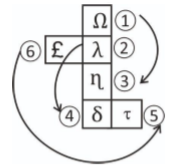
So, by folding the unfolded dice, only option (b) figure is possible.
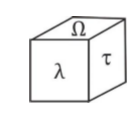
Hence, option (b) is the correct answer.
Incorrect
Solution (b)
Explanation:
Here, 1-3, 2-4 and 5-6 are opposite to each other

So, by folding the unfolded dice, only option (b) figure is possible.

Hence, option (b) is the correct answer.
-
Question 32 of 35
32. Question
Passage – 1
‘Education for all’ is one of the major tasks being carried out by the Indian government but still, we have the lowest female literacy rate in Asia. India is working but the pace is slow as we haven’t achieved what we should have been so far. As per a report, India’s country-wide female literacy rate is 70.3%, while the male literacy rate is estimated at 84.7%. India’s average literacy rate stands at 77.7%, according to the NSO. Women’s education is critical to the country’s entire development. A well-educated woman is capable of managing her personal and professional life.
Q.32) Based on the passage given above, the following assumptions have been made:
- To provide equal education to females, government should end the policy of affirmative action.
- Women’s education has seen rapid growth in the last few years but still falls behind the male literacy rate.
Which of the above assumptions is/are valid?
Correct
Solution (c)
Explanation:
Statement 1 is correct. The given option reflects an inference drawn from the information given in the passage. Refer to lines, “The production of electronic equipment is causing potentially unbalanced waste of limited metals and resources in general, which could become a critical issue in the long run” and “The production of electronic gadgets has led to the consumption of various chemicals, water and finally fossil fuels that have all left environmental impacts.” Waste of metals, consumption of water, fossil fuels etc. show that certainly promotion of IoT technologies will negatively impact the environment. So, this statement is a rational and logical Inference.
Statement 2 is correct. The line, “Unfortunately, the recycling rate of electronic waste is low and currently in the amount of about 20% which makes matters questionable regarding the available resource capacity to produce IoT products when taking into account the rising market demands”. This shows that there is an issue of recycling with electronics equipment production. Therefore, it will be correct to infer that the concept of circular economy, which is based on recycling, offers a reasonable solution to the challenges in the passage. So, this statement is a rational and logical Inference.
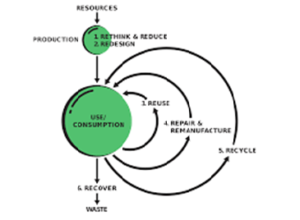 Incorrect
Incorrect
Solution (c)
Explanation:
Statement 1 is correct. The given option reflects an inference drawn from the information given in the passage. Refer to lines, “The production of electronic equipment is causing potentially unbalanced waste of limited metals and resources in general, which could become a critical issue in the long run” and “The production of electronic gadgets has led to the consumption of various chemicals, water and finally fossil fuels that have all left environmental impacts.” Waste of metals, consumption of water, fossil fuels etc. show that certainly promotion of IoT technologies will negatively impact the environment. So, this statement is a rational and logical Inference.
Statement 2 is correct. The line, “Unfortunately, the recycling rate of electronic waste is low and currently in the amount of about 20% which makes matters questionable regarding the available resource capacity to produce IoT products when taking into account the rising market demands”. This shows that there is an issue of recycling with electronics equipment production. Therefore, it will be correct to infer that the concept of circular economy, which is based on recycling, offers a reasonable solution to the challenges in the passage. So, this statement is a rational and logical Inference.

-
Question 33 of 35
33. Question
Six family members are Ashish, Krisiv, Ketan, Deepesh, Ekta and Manoj. Ketan is the sister of Manoj. Krisiv is the brother of Ekta’s husband Ashish. Deepesh is the father of Ashish and grandfather of Manoj. There are two fathers, three brothers and a mother in the group. Who is the mother?
Correct
Solution (a)
Explanation:
We can make the following family tree using the information provided in the question:
Ekta is the mother. Hence, option (a) is the correct answer.
Incorrect
Solution (a)
Explanation:
We can make the following family tree using the information provided in the question:
Ekta is the mother. Hence, option (a) is the correct answer.
-
Question 34 of 35
34. Question
Passage – 2
Children born to parents with lower levels of education were less likely to have access to a Smartphone, although even the availability of a Smartphone in the household may not have necessarily led to greater access for children. Over a fourth of children in households with a Smartphone could not access it (for those in the lower grades the numbers are significantly higher). This has already begun to impact learning outcomes — children are unable to catch up with their curriculum.
Q.34) What is the most logical conclusion that can be drawn from the passage given above?
Correct
Solution (d)
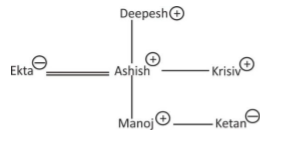
Explanation:
Option (a) is incorrect. The last sentence of the passage mentions, “This has already begun to impact learning outcomes — children are unable to catch up with their curriculum.” The conclusion is partially true, but the passage mentions parents with lower levels of education, not poor parents. We cannot assume that parents with lower levels of education are poor. So, this option is incorrect.
Option (b) is incorrect. The passage mentions, “Over a fourth of children in households with a Smartphone could not access it (for those in the lower grades the numbers are significantly higher).” So, for the lower grade students, the percentage is significantly higher and that cannot be around one fourth. So, this option is incorrect.
Option (c) is incorrect. The passage mentions, “Although even the availability of a Smartphone in the household may not have necessarily led to greater access for children.” This implies that such parents may or may not give their children smartphones. But the reasons behind it have not been discussed. So, this option is incorrect.
Option (d) is correct. The passage mentions that such households are less likely to have smartphones and even if they do, it is not necessary that they share them with their children. While other kids may have access to smartphones. So, students without access to smartphones are facing inequality at this front. This shows inequality, which is greater at lower grades. So, this is the correct option.
Incorrect
Solution (d)

Explanation:
Option (a) is incorrect. The last sentence of the passage mentions, “This has already begun to impact learning outcomes — children are unable to catch up with their curriculum.” The conclusion is partially true, but the passage mentions parents with lower levels of education, not poor parents. We cannot assume that parents with lower levels of education are poor. So, this option is incorrect.
Option (b) is incorrect. The passage mentions, “Over a fourth of children in households with a Smartphone could not access it (for those in the lower grades the numbers are significantly higher).” So, for the lower grade students, the percentage is significantly higher and that cannot be around one fourth. So, this option is incorrect.
Option (c) is incorrect. The passage mentions, “Although even the availability of a Smartphone in the household may not have necessarily led to greater access for children.” This implies that such parents may or may not give their children smartphones. But the reasons behind it have not been discussed. So, this option is incorrect.
Option (d) is correct. The passage mentions that such households are less likely to have smartphones and even if they do, it is not necessary that they share them with their children. While other kids may have access to smartphones. So, students without access to smartphones are facing inequality at this front. This shows inequality, which is greater at lower grades. So, this is the correct option.
-
Question 35 of 35
35. Question
When 876 is added to another 3-digit number 2P3, we get a four digit number 10Q9 & 10Q9 is divisible by 11 then the value of P- Q is
Correct
Solution (c)
Explanation:
Out of four consecutive integers two are even and therefore, their product is even and on adding 1 to it, we get an odd integer. So, n is odd. Some possible values of n are as under :
n = 1 + (1 × 2 × 3 × 4) = (1 + 24) = 25 = 52
n = 1 + (2 × 3 × 4 × 5) = (1 + 120) = 121 = 112
n = 1 + (3 × 4 × 5 × 6) = (1 + 360) = 361 = 192
n = 1 + (4 × 5 × 6 × 7) = (1 + 840) = 841 = 292
And so on…..
Hence, n is odd and a perfect square.
Incorrect
Solution (c)
Explanation:
Out of four consecutive integers two are even and therefore, their product is even and on adding 1 to it, we get an odd integer. So, n is odd. Some possible values of n are as under :
n = 1 + (1 × 2 × 3 × 4) = (1 + 24) = 25 = 52
n = 1 + (2 × 3 × 4 × 5) = (1 + 120) = 121 = 112
n = 1 + (3 × 4 × 5 × 6) = (1 + 360) = 361 = 192
n = 1 + (4 × 5 × 6 × 7) = (1 + 840) = 841 = 292
And so on…..
Hence, n is odd and a perfect square.
All the Best
IASbaba



